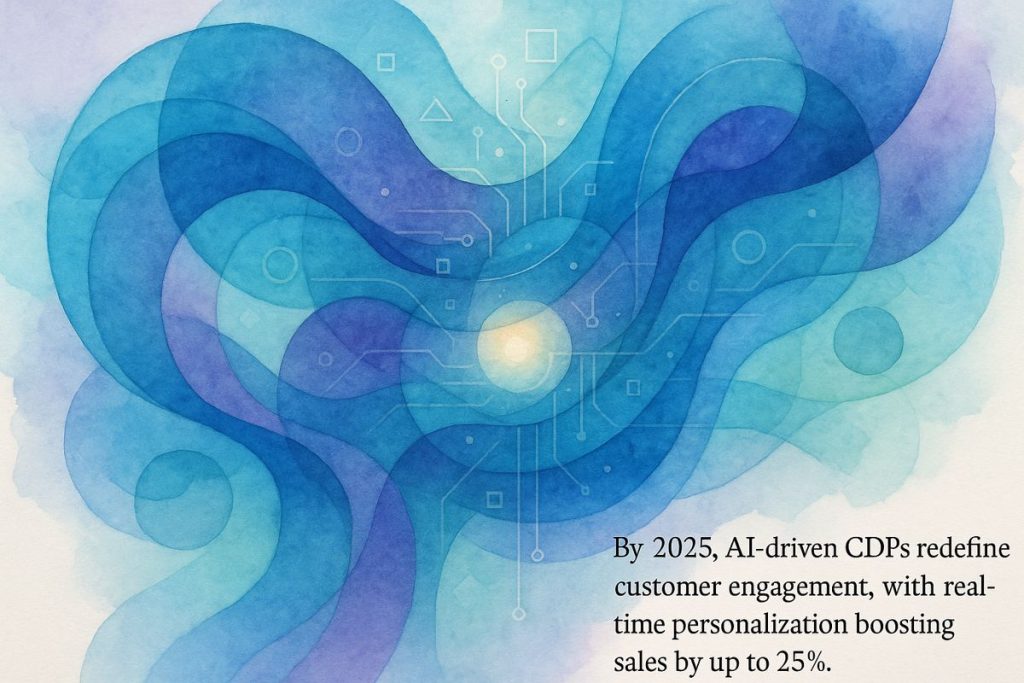In 2025, AI-powered Customer Data Platforms (CDPs) have changed from dusty data storage to lively, smart engines that connect and understand customer information in real time. These platforms use AI to create personal experiences, predict what customers want, and help companies follow strict privacy rules. Big companies like Salesforce, Adobe, and Oracle are racing to make their CDPs smarter and more trustworthy. Now, customer data flows smoothly across all channels, making businesses more connected to their customers than ever before.
What is driving the rise of AI-powered Customer Data Platforms (CDPs) in 2025?
AI-powered Customer Data Platforms (CDPs) in 2025 are transforming customer data management by using generative AI for real-time personalization, predictive analytics, and compliance automation. These next-gen CDPs unify data across channels, enhance engagement, and ensure privacy, fueling rapid market growth and industry adoption.
Scene Change: From Dusty Repositories to Lively Data Orchestras
Let’s set the stage: not so long ago, Customer Data Platforms (CDPs) were the librarian’s attic of the digital world—crammed with scattered, half-indexed scraps of the customer’s life, quietly gathering dust. But 2025? Now the CDP is less a dreary archive and more a hyperspectral command center, pulsing with generative AI’s synaptic fire. No longer static, these platforms are kinetic—imagine a jazz ensemble riffing off your customers’ every note. And if you work in pharma or life sciences, you know there’s real velvet-glove pressure: every move monitored, every byte scrutinized.
Sometimes, at 7am with the first espresso, I have to ask myself—how did we get from those flat spreadsheets to this swirling palimpsest of customer understanding? I suppose the answer is as messy as an email inbox, but the transformation is undeniable.
Numbers and Names: Who’s Playing This Game?
This isn’t just hype. Look at the numbers: the global CDP market’s value is expected to leap from $5.72 billion in 2024 to around $7.39 billion in 2025, and (wait for it) may even soar to $28.2 billion by 2028. The U.S. alone is poised to hit $6.4 billion by 2028, according to GlobeNewswire and The Business Research Company. The usual titans—Salesforce, Adobe, Oracle, SAP, Microsoft, and Snowflake—are in the thick of it, each one elbowing for a seat at the grownups’ table. Not to forget, Adobe’s latest AI-driven update left my team abuzz for a week, though there may have been more caffeine than code at work.
Competition Heats Up
Yet, it’s not just about making numbers dance. These vendors are locked in a cold war of AI innovation—deploying differential privacy, federated learning, and even the odd synthetic dataset to help clients navigate the labyrinthine corridors of GDPR, HIPAA, and CCPA compliance. The stakes? Only the future of digital trust.
The Brainy Heart of Next-Gen CDPs
From Aggregation to Autonomy
I remember my first encounter with a “smart” CDP—let’s just say it was less Einstein and more Clippy, the old Microsoft mascot, asking if I wanted help with my segmentation. Now, in 2025, generative AI is the real conductor. CDPs don’t just collect data—they transmute it. A single click, and your platform sifts through years of purchase history, parses unstructured social posts, and whispers real-time, personalized offers directly into the marketer’s ear.
It’s a bit like having Dostoyevsky’s insight paired with the speed of a Tesla Model S Plaid. Okay, maybe I exaggerate. But when companies like Salesforce and Adobe have tweaked engagement and sales upwards—25% and 15%, respectively—it’s hard not to feel a jolt of admiration. Or envy.
Predictive Alchemy
The modern, AI-infused CDP predicts customer churn with all the subtlety of a chess grandmaster three moves ahead. You’ll find it orchestrating the “next-best-action” for every individual, whether they’re a chronic online window-shopper or a pharma procurement lead. How does it taste? Like the first sip of a perfect cortado—smooth, unexpected, brimming with potential.
Compliance, Privacy, and the Art of Not Getting Sued
Staying Ahead of the Regulators
If you’ve ever had to explain GDPR to a room full of anxious executives, you know the cold sweat that follows. CDP vendors in 2025 have responded with almost baroque elegance—integrating privacy-preserving techniques like federated learning and synthetic data, as highlighted in SuperAGI’s analysis. The platforms perform their governance rituals so customers’ secrets remain safe, even as insights are drawn in real time.
Here’s the kicker: moving CDPs to the cloud didn’t just save money—it let organizations blend disparate data sources and keep the compliance officers relatively happy. Mostly.
A Pinch of Humility
Early last year, I misconfigured a privacy setting in a demo CDP and triggered what can only be called mild existential panic. Lesson learned: automation is only as good as its governance layer. Bam! A healthy respect for fine print was born.
Use Cases and Real-World Impact
Omnichannel or Bust
Let’s get tactile. Today’s CDPs don’t just unify data, they create a living, breathing “customer skin”—multi-sensory, adaptive, and, yes, a little uncanny. Web clicks, in-store transactions, mobile app swipes, third-party datasets—they all coalesce into a single, high-resolution portrait.
Sales teams, marketers, even compliance officers get actionable,
